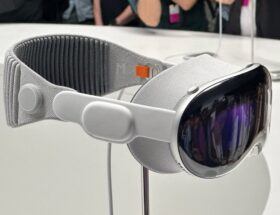The next generation of Apple AirTags will look the same, but will have improved range and location tracking.
 0 Facebook x.com Reddit
0 Facebook x.com Reddit
Apple is rumored to release a new AirTag in 2025, which will provide more accurate device tracking with a new, longer-range Ultra Wideband chip.
The AirTag originally had Ultra Wideband. It’s at the heart of the AirTag and allows for accurate tracking at relatively close range.
However, a new report on Sunday morning dives deeper into the main improvement to the device. The next AirTag is said to have an Ultra Wideband chip that’s “on par” with the one in the iPhone 15.
The current AirTag can accurately track at ranges between 33 and 100 feet, depending on a number of factors. Sunday morning’s report claims that the new chip should triple that number. It’s unclear whether the increased range will require a newer iPhone.
What is Ultra Wideband?
Ultra Wideband arrived with the iPhone 12 in 2020. The arrival of Ultra Wideband support in the HomePod mini, as well as the Apple Watch Series 6, has sparked more talk about the technology and its potential future uses by the company.
Ultra Wideband, commonly referred to as UWB, is a wireless communication protocol that functions using radio waves. Essentially, it can be used to pass messages between devices, making it somewhat analogous to Bluetooth or Wi-Fi.
Since it has potential applications for personal area network communications, namely allowing devices on a person to communicate with each other, there is a lot of overlap with the more established Bluetooth. However, the way it works means that it can offer more functionality than the other two communication types cannot provide.
The main function it provides is highly accurate location tracking, with devices like the AirTag and iPhone using UWB being able to determine distance and even the location of other equipment relative to itself to within a few inches.
UWB is a pulsed system that repeatedly emits signals and then turns off before repeating. While each pulse can occupy the entire range of its allocated bandwidth, the extremely short transmission time of each pulse, as well as the relatively low-power nature of consumer-grade UWB, make it highly unlikely that it will interfere with other systems in the same bands.
The pulsed nature of UWB allows for location tracking in a number of ways. For starters, by regularly sending out a pulse of data, it can let other nearby devices know of its existence, or vice versa if it receives a pulse from another device.
Using UWB and its wide frequency range also allows devices to perform time-of-flight (ToF) calculations, which is how long it takes for a response to be received, which provides a much more useful data point: how far apart devices are.
Using such a wide frequency range allows the system to virtually overcome multipath propagation, which is when radio waves take multiple paths to reach their destination, such as by bouncing off surfaces.
Since some frequencies used in the pulse are likely to reach their intended recipient directly via line-of-sight, calculations can be based on them rather than slower redirected signals on other frequencies, resulting in more accurate calculations.
A new AirTag is expected to arrive in 2025
This isn't the first time this has been rumored, and it's an obvious addition. Bloomberg last talked about it in November,
The new AirTag is reportedly codenamed B589, and is also believed to have reached the production testing phase, ahead of what will likely be a mid-2025 release.
The new model is expected to look the same. However, it will use the same Ultra Wideband chip with improved location tracking and increased range.
Another change that is said to be coming to the new AirTag is a change to the internal design that will make it harder to remove the speaker. This is to prevent stalkers from easily disabling the speaker.
This rumored update to AirTags will be the first hardware change to the device since Apple introduced the tracker in April 2021.
Follow AppleInsider on Google News









